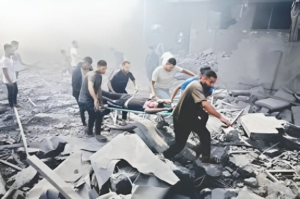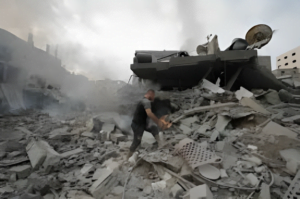Blocks of the Gaza refugee camp are leveled by airstrikes, sparking fury, anguish, and a dangerous new phase of the conflict.
Aviv Tel Aviv Huge explosion craters and debris-filled moonscapes, structures reduced to concrete skeletons, and raspy sobs of sorrow and rage: The fierce Israeli airstrikes on Tuesday that targeted the largest camp for refugees in the Gaza Strip and left hundreds dead or injured marked the beginning of a dangerous new stage in Israel’s conflict with Hamas.
Since October 7, when Hamas launched catastrophic strikes within Israel, the battle has resulted in several deadly localized bombardments, including the aerial assault on the Jabaliya refugee camp. Intense ground battles have also taken place over the past five days, according to both sides, and have extended into Hamas’ extensive underground network.
Dangerous new phase

Marwan Sultan, the medical director of the Indonesian Hospital nearby, described the Jabaliya hit as “a waterfall of casualties.” He spoke of a frantic flood of injured people arriving by whatever means of transportation, including motorbikes, vehicles, and donkey carts.
Night quickly descended on the scene of destruction, adding to the chaos and terror and making the mission of recovering casualties considerably riskier and more challenging.
Sultan remarked, “They’re using flashlights and anything else to save whoever they can.” According to him, the majority of the deceased and injured were locals who resided in run-down structures, such as shacks with corrugated metal roofs that provided no defense against the intense explosions.
Social media videos showed people scurrying around burned-out structures and hurriedly excavating in an attempt to locate survivors. As they attempt to yank the young man away from the body of a relative, he cries. Locals struggle to remove concrete debris with their bare hands.
The tragic raid on the densely populated camp, which was home to over 110,000 Palestinians prior to the start of the war, brought the difficulty of launching a full-scale attack on terrorist strongholds without seriously endangering and murdering a significant number of civilians into stark new light.
The Gaza Health Ministry, which is under the control of Hamas, reports that since hostilities began, more than 8,500 people have died within Gaza.
The Jabaliya assault also brought to light a dynamic that will surely persist for the duration of the war: Israel bragging about its military prowess while Hamas charges it with needless civilian casualties.
The bombardment was justified by the Israeli military as a strike against “terrorists and terror infrastructure” in the camp. The attack claimed to have killed a “large number” of fighters who were with Hamas commander Ibrahim Biari, who it identified as the commander of the Central Jabaliya Battalion.
All in all, it said that the airstrike had “damaged Hamas’ command and control” in the region. Hazem Qassem, a spokesperson for Hamas, however, denied that any of the organization’s leaders had ever visited Jabaliya and charged Israel with encouraging “ugly crimes against civilians.”
The incident also highlighted—not for the first time—the pointlessness of Israel’s constant demands that Gazans leave the heavily populated north of the coastal enclave. According to Israeli officials, northern Gaza is Hamas’ “center of gravity” or “heartland.” This was said by military spokesperson Jonathan Conricus.
Israel’s army has advised Gazans to evacuate southward since the beginning of the conflict, but raids have also struck Nusseirat, a populated camp further south in Gaza.
With food, water, and gasoline becoming increasingly scarce and the humanitarian situation becoming worse by the day, many residents of the besieged enclave are refusing to leave their homes, claiming there is nowhere safe to go.
Another repeated trend was Hamas’ attempt to inflame the already palpable animosity in the neighborhood toward Israel and its supporters by claiming that Washington was also to responsible for what it dubbed a “massacre” in Jabaliya.
As Houthi rebels in Yemen’s impoverished country claimed to have launched missiles and drones toward Israel on Tuesday, fears of a larger regional conflict increased. Although it did not explicitly confirm the attack, the Israeli military claimed to have detected “aerial threats” coming from the Red Sea.
The details of Israel’s military’s increasing incursion into Gaza, which started on Friday when Israeli troops and tanks started conducting continuous operations inside the region for the first time, have not been made public. It has admitted that two of its men perished in the combat on the ground.

According to the Hamas-run Palestinian Interior Ministry, Israeli soldiers have advanced as far north of Gaza City, near Karama. Israeli soldiers were reportedly making efforts to “separate” the northern and southern parts of Gaza.
Fears for the roughly 240 hostages that Israel claims Hamas has have halted the ground battle. On October 7, the terrorists broke over the Gaza barrier and massacred hundreds of troops and over a thousand civilians in a series of Israeli towns. Additionally, the subdued pleas of American officials have slowed it down.
Officials from the White House and the U.S. State Department chose not to comment on the Jabaliya attack or the rapidity with which it was escalating tensions throughout the Arab world.
Secretary of State Antony J. Blinken and Defense Secretary Lloyd J. Austin III testified before the Senate Appropriations Committee before word of the attack even spread, advocating for billions more in military aid for Israel and allocating a small portion of that sum for humanitarian aid to the Palestinians.
According to Blinken, the United States is still adamant that Israel must take all reasonable precautions to avoid civilian fatalities, seeing this as both a moral and a strategic need “for Israel’s security” and to keep the conflict from getting out of control.outside regional control.
However, Israel and the Biden administration are still steadfastly opposed to a cease-fire.
Several dozen protesters in the room continuously stopped Blinken as he was speaking, yelling things like “Cease-fire now!” and “Palestinians are not animals!” Before Capitol police led them out of the chamber one by one, they raised their red-stained palms in the air.
According to the government, Hamas would only utilize a cease-fire to reorganize and rearmament.
According to Matthew Miller, spokesperson for the State Department, “it’s a call for Israel to cease fire; I don’t think there’s anyone actually expecting that Hamas would agree to a cease-fire — a terrorist organization.”
The conflict hasn’t stopped Hamas from launching rockets at Israeli cities thus far.
Following the Jabaliya strike, the armed branch of Hamas, the Izzidin al Qassam Brigades, said on the messaging app Telegram that it was moving toward Tel Aviv, where sirens cried out and huge booms were audible on Tuesday night.
Spokesman Abu Ubaida for the Qassam Brigades stated in an audio message released later on Tuesday that Hamas was still in the early stages of its defensive operations and that Gaza will serve as a “graveyard” for its adversaries.
Another unstable dynamic that was exacerbated by the Jabaliya strike was the increase in violence in the West Bank, where Hamas and Israel’s conflict has resulted in a sharp rise in tensions and casualties.
Hundreds of Palestinians marched in the West Bank cities of Jenin and Ramallah on Tuesday, while clashes broke out between Palestinian protestors and Israeli police in East Jerusalem late in the evening.
Fatah, a former competitor of Hamas, declared a nationwide strike on Wednesday, dubbed it a “day of rage.”
In the midst of radical Jewish settlers’ increased efforts to expand into areas that Palestinians believe would become part of a future state, Israel has launched a campaign to eradicate Palestinian resistance groups.
According to Palestinian sources, since October 7, there have been over 120 Palestinian deaths in the West Bank and over a thousand arrests.
However, the West Bank’s acceptance of the Palestinian Authority, whose security cooperation with Israel is widely derided, has also been weakened by the violent spiral.
“Even if we lost the West Bank and suffered 10,000 martyrs, as long as Hamas survives, we will remain content,” stated Abu Ahmad, a 21-year-old combatant affiliated with Islamic Jihad in the Jenin town located in the northern West Bank.
“We rise no matter how much we fall.”
theusastories.org.in


Average Rating